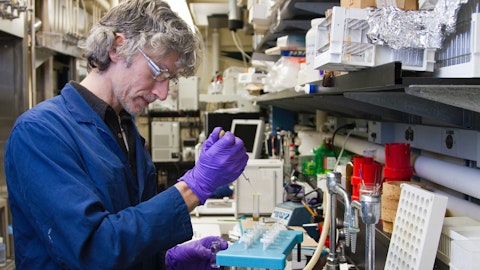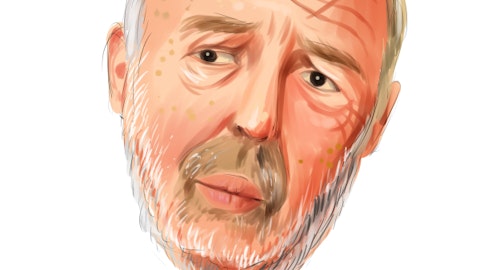Colin Bristow: Good afternoon and congrats on all the progress. Maybe one on TIGIT and dompenanumab. The — just what is it that gives you the confidence that the Fc silent construct is the right approach when I think at least the animal data suggest that this may not be preferred. And then as you think about the upcoming study, ARC-7, could you talk about the frequency of scanter because this has come up as a point of at least discussion with regards to the comparator trials and the frequency of scans. Thank you.
Merdad Parsey: Sure. This is Merdad again. Excellent question. Thank you for that. We — in terms of our confidence, I think to your point, look, I think there was a lot of debate a couple of years ago. We shared in that debate, with what the preclinical data was showing. And as you know, the data they were conflicting preclinical data, including some data that suggested maybe an FC-silent may not work. But which is why we ran the studies the way we did and very importantly, why we ran ARC-7. The objective there was really to establish whether an FC-silent now would demonstrate a benefit relative to FC-active molecule. Part of the hypothesis there is what happens in the periphery and whether depleting effector cells with TIGIT could actually be harmful with FC-competent molecule relative to an FC-nonmolecule.
And our confidence really comes from our ARC-7 data. I think the ARC-7 data really answered that question. We clearly show a benefit when added on to a PD-1. The PFS data exceed our bar for moving forward. And so we really think that we’ve answered that question in the clinic as to whether the FC-now matters.
Jacquie Ross: Hannah, let’s move to our next question.
Operator: The next question is from Chris Schott with JPMorgan. Please proceed.
Chris Schott: Hi, great. Thanks so much. Just a question on the COVID business. I know it’s volatile, and I know at the same time, the Street doesn’t seem to model much of a tail for Veklury or GS-5245 at all in numbers beyond this year. We’ve got Pfizer’s and others, then talking about more sustainable COVID businesses, I guess, off of 2023 level. So I just missing your thoughts on just how you’re thinking about the business longer term? And is this a meaningful franchise for you over time? Or are you really thinking of this continuing to fade down beyond this year? Thank you.
Johanna Mercier: Sure, Chris. It’s Johanna. Yes. So definitely, we’ve changed a little bit. Our position on this one has evolved from 2020 to where we are today, obviously. I think we do truly believe that the Veklury business is much more sustainable than we’ve ever seen before, let alone as we think about kind of where we’re going with COVID-19, including the oral that Merdad can speak to. The one piece that we’ve seen is — it’s maybe a little bit different than some of the orals that you’re referring to is One is Veklury has been part of a commercial model since October of 2020. So we haven’t had such big inventory lows at the government level like some others have had. So really, what you see probably 85% to 90% of revenues in 2022 are truly reflecting the demand for Veklury in 2022.
And so therefore, coming into 2023, we feel very strongly that Veklury, because it’s still the only antiviral indicated at the hospital level at this point in time because of the fact that in many countries around the world, it is the treatment of choice when they decide to treat hospitalized patients. I think there’s really an incredible continuing opportunity for us to ensure that Veklury has is accessible to all these patients. And so that’s why we think the model is quite sustainable moving forward. I would also just add that our label has broadened over the last year in some. We have a very strong body of evidence, including mortality as well as we have guidelines endorsement with the NIH as well as the WHO. So all of those people all of those pieces together actually make for a strong Veklury color position in 2023, but actually and beyond.
And maybe I’ll just pass it over to Merdad to talk a little bit to how we’re thinking about COVID-19 as a whole with the oral.
Merdad Parsey: Yes. Just 2 seconds. I think you’re right to point out the uncertainties that we all have and that we’ve seen with outpatient COVID. And we have a lot of confidence in the mechanism of 5245 given what our expertise in the molecule itself and how well behaved it is. And we are going to push forward and do our best with both the high-risk and standard risk study and the uncertainties in terms of the pandemic will really determine what happens from here. So we will definitely keep you updated as to how that goes from here on out.
Operator: Thank you. The next question is from Brian Abrahams with RBC. Please proceed.
Brian Abrahams: Hey good afternoon. And congrats on the quarter, and thanks for taking my question. Maybe continuing on the COVID theme on 5245, the Oaktree study. Can you talk a little bit more about the assumptions you’ve made in powering the primary endpoint here for the standard risk patients. And then help us understand how Oaktree and Birch might fit together to support U.S. and ex-U.S. approvals across the 2 populations you’re studying? Thanks.
Merdad Parsey: Sure. Very briefly. The — to your point, one is in the high-risk population, right? So I think that’s important. Those are people who have risk factors, whether or not they’ve been vaccinated and then the standard risk, which is people without risk factors. And — those are very different populations. The end points are different in terms of what we’re looking for and the high risk we’re going to be looking for the ability to prevent things like hospitalization. And the standard risk, it would be looking for things like symptom improvement. And I think, again, I’ll just reiterate that I think the uncertainties in terms of those factors and importantly, the underlying event rate is real. And so we’ve made a number of assumptions around what that background rate will be.
And we’ve built into the trials, checkpoints to make sure that our assumptions are correct. And we have the ability to modify our program based on what the underlying event rates are. So that sort of helps mitigate the risks and the uncertainties. So we’ve gone in fairly eyes open to that.
Operator: Thank you. The next question is from Mohit Bansal with Wells Fargo. Please proceed.
Mohit Bansal: Great. Thanks for taking my question and congrats on the progress. Maybe if you could comment on your overall market share in HIV space and how it has been progressing. What I want to understand is that is there a scenario where your entire business growth could be better than the market growth as you gain share at this point? Thank you.
A – Johanna Mercier: Sure. Hi, Mohit, it’s Johanna. I think as we look at HIV as a whole, we’re looking at about a 5% year-on-year growth. And of course, that’s mostly driven by demand, namely Biktarvy. And so it’s probably important to talk about the share there. So our total Gilead share is still in the low 70s, and we’ve been quite stable at that level. We saw a little bit of the dip when we got the Truvada, Atripla LOEs, and that’s the only decline that we’ve seen there and really held steady, where you see nice growth, of course, is Biktarvy. Our year-on-year growth for Biktarvy is 20% in 50-year post launch. And I think that’s the piece of the puzzle that’s really driving the overall HIV business. In addition, to what’s going on in PrEP with Descovy.
To your point about the market growth, we’ve seen market growth around 2% to 3% year-on-year, both in the U.S. as well as in Europe, and we’ve assumed that we’re kind of assuming that for some years to come. And I do think there’s still enormous opportunity for continued growth in that market. And one of the main reasons why is there’s still an opportunity for increasing treatment rates so from diagnosis to treatment, but also further penetration in underserved patient populations. And so at this point in time, with United Nations goal at 95,95,95 for testing, treatment and virologic suppression we’re only about 70%, 75%. So if we were to get to those goals, you’re looking at over 350,000 more patients into the system. So I think you’re absolutely right.
I think there’s a great opportunity for us to continue to grow Biktarvy and our HIV business at Gilead.
Operator: Thank you. The next question is from Umer Raffat at Evercore. Please proceed.





